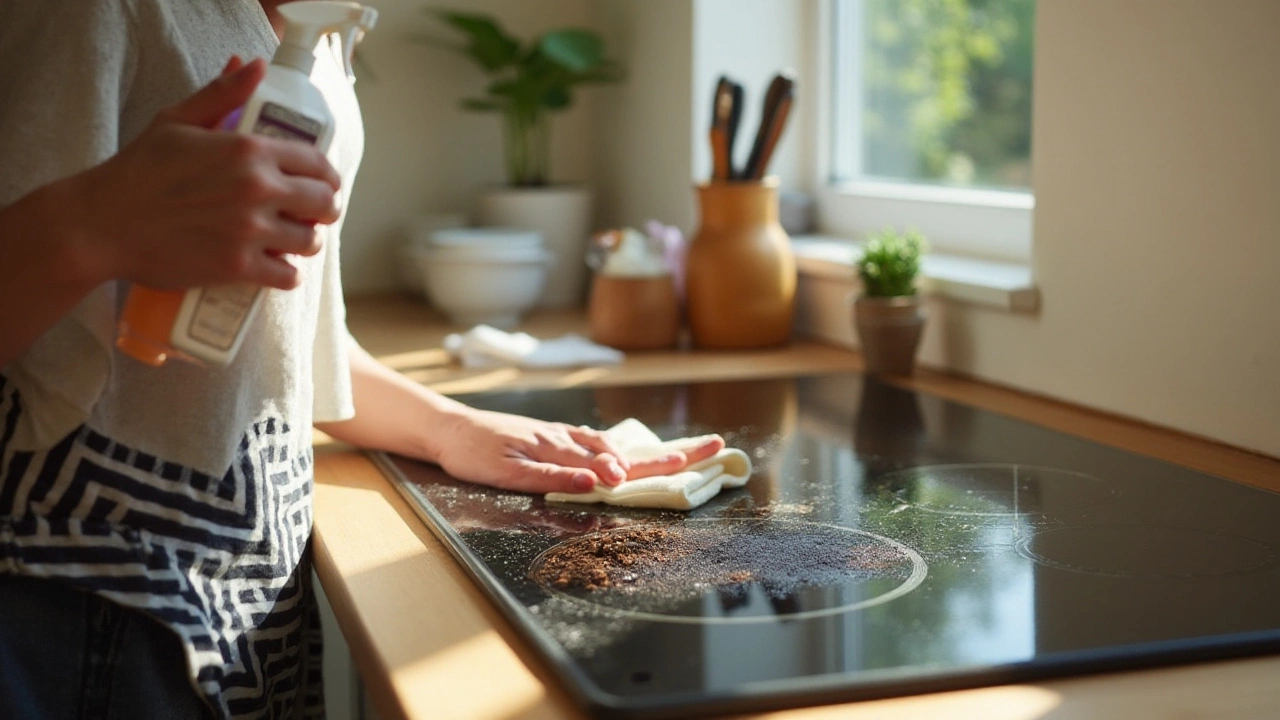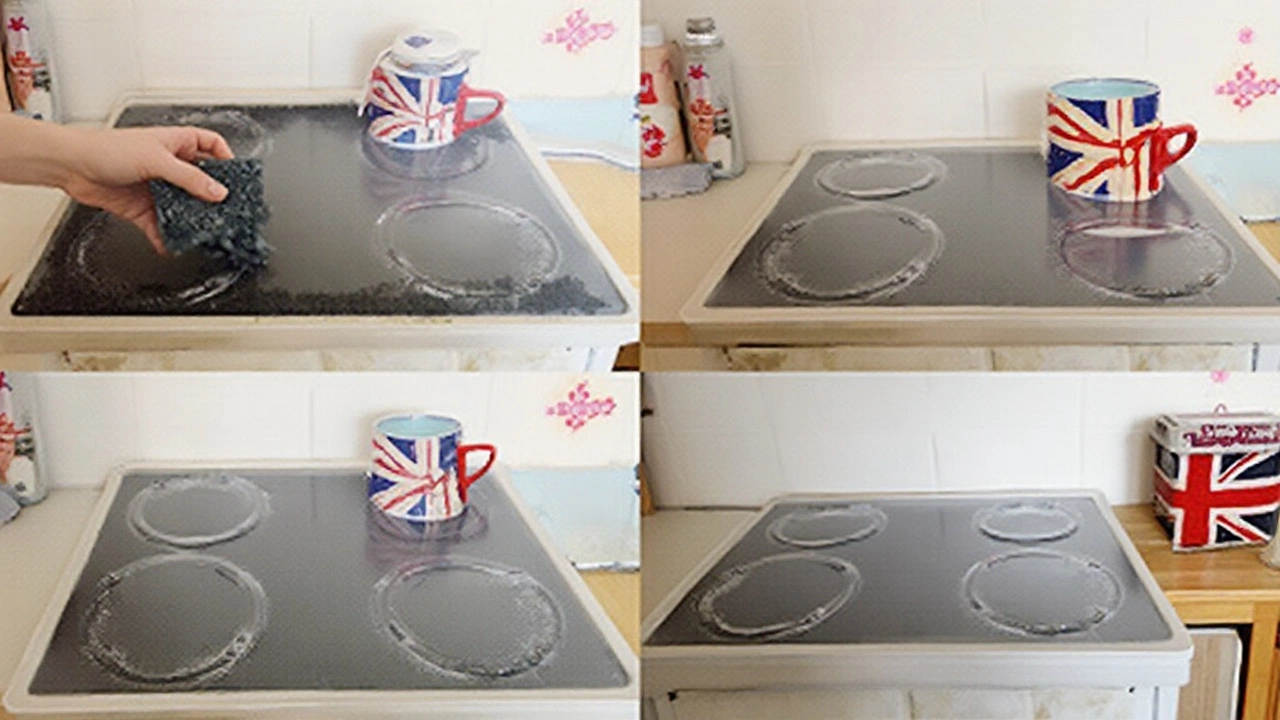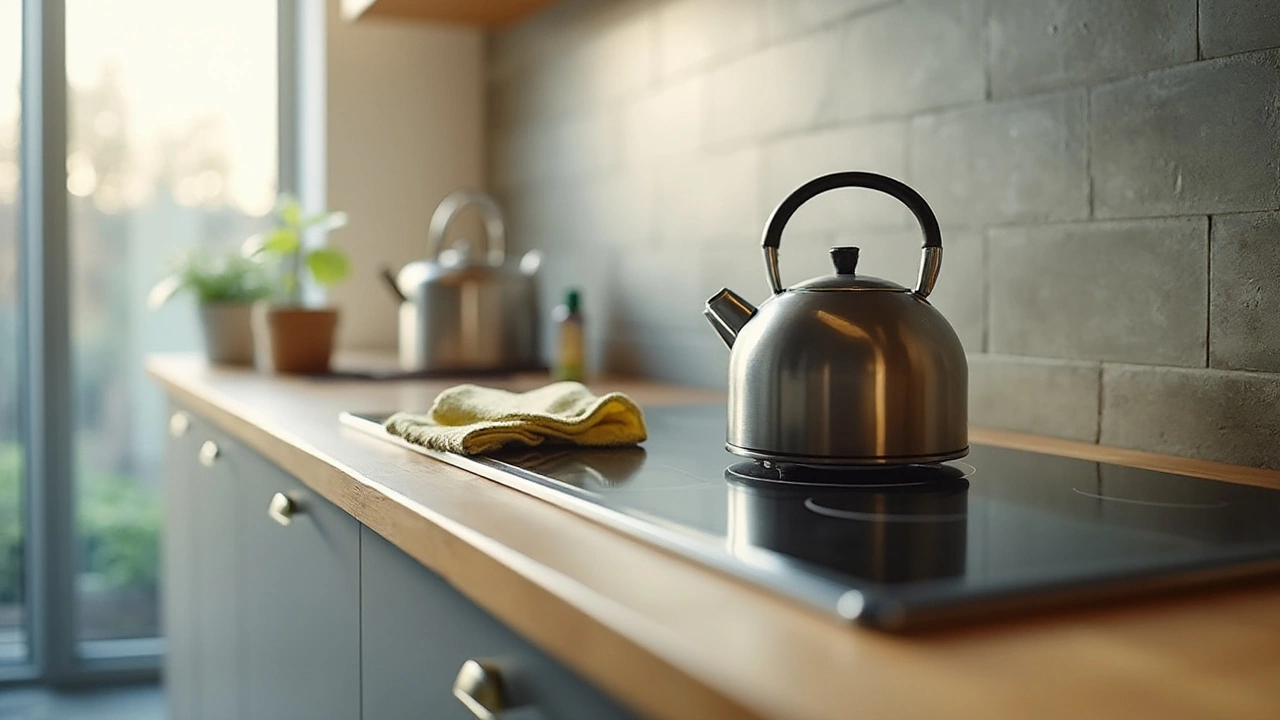Electric hobs are trusty companions in many kitchens, yet they often face wear and tear. One common issue many encounter is a burnt hob, whether due to spilled food or overheating. But fret not, you don't always need a professional to bring it back to life.
In this guide, we'll explore how to repair a burnt electric hob using easy-to-follow methods. You'll learn about the tools you'll need, the steps to take, and how to prevent future incidents. So, if your hob has seen better days, read on for some straightforward advice to help it shine again.
- Understanding Hob Damage
- Required Tools and Materials
- Step-by-Step Repair Guide
- Preventive Maintenance Tips
- When to Seek Professional Help
Understanding Hob Damage
Electric hobs, like any kitchen appliance, are not immune to the trials of time and usage. Their smooth and sleek surfaces belie a vulnerability to high temperatures, misplaced pans, and the storytelling stains of accidental boils-over. Understanding what constitutes hob damage is the first step in rectifying it effectively. When you first notice that burnt crust or a darkened ring, it might be tempting to simply ignore it, assuming it's par for the course in busy kitchens. However, allowing that damange to linger can develop into more consequential issues over time.
A burnt electric hob isn't just an aesthetic blemish. It's a sign that there might be persistent residual heat causing further wear or even subtle warping in the hob's metal beneath the surface. Many people see their hobs form a rainbow of discolorations, from straw yellow hues to deep blue-black shades. Knowledgeable hob enthusiasts know that these colors derive from different temperatures. However, these differences can indicate heat is not being distributed evenly, hinting at possible heating element issues. A fascinating fact widely recognized among hobbyists is that stains often follow a predictable pattern: they're most prominent where the metal struggles to cope with repetitive heat, usually around the electrode connections.
When considering why hobs suffer burns, it's crucial to consider what has been left on them for too long or boils from the pans. Over many uses, small amounts of food and liquid splashes accumulate, gradually cooking themselves further into the hob material each time the surface is heated. - inviting more extreme stains over time. Regular cleaning works wonders in maintaining your hob's appearance and function, but knowing what kind of damage you're dealing with is half the battle. As quoted by renowned appliance expert Guido Veloce,
"Every scar on a hob tells a story of culinary adventure or misadventure, and knowing these stories is vital to keeping your kitchen running smoothly."
Thus, understanding the specific nature and causes of your hob's affliction offers clues to appropriate remedies. Regular inspections of surface integrity to catch early signs of damage can prevent more severe degradation. Many hob owners enter discussions about their experiences on online forums, highlighting their narratives which often echo the sentiment that "an ounce of prevention is worth a pound of cure." By grasping the basics of hob damage, you're not only preparing to fix what's broken but equipping yourself to stave off future mishaps. Recognizing these signs before they escalate helps ensure your electric hob stays efficient and reliable, while also sustaining its attractiveness in the heart of your kitchen.
Required Tools and Materials
Tackling a burnt hob fix yourself might seem daunting, but with the right tools handy, it becomes a straightforward task. Before you begin, make sure you unplug the hob for your safety. This is critical, as working with electricity can be dangerous, and safety comes first.
The journey to restore your electric hob starts with gathering the necessary materials. Initially, you'll need a gentle cleaning solution; this is crucial to help remove any residue without damaging the surface. Additionally, a non-abrasive sponge or cloth will prove vital in cleaning without scratching. Baking soda has proven to be an effective cleaning agent for burnt marks, acting as a gentle abrasive that can lift stains without causing harm.
Next on your list should be a plastic scraper. Metal ones might scratch the surface, so opting for plastic keeps the integrity of your hob’s face. You might be surprised to learn that a common household item, white vinegar, plays a significant role as well. Its acidity aids in breaking down grime and residue. Consider pairing it with a microfiber cloth for a thorough polish. If the burn stains are more stubborn, steel wool pads could be your last resort, but use them cautiously to prevent undue damage.
Sometimes, the cleaning isn't enough, and damaged parts need replacement. Have a contact number for your hob's manufacturer or a skilled technician, as spare parts might need ordering. A toolkit with screwdrivers of varying sizes could also be useful when adjustments or panel removals are necessary. In some cases, a heat-resistant paint might come into play, especially if there's visible damage to the surface which impacts the look of your appliance.
Finally, consider preventative tools. Protective covers can be purchased to place over your hob when not in use. This helps reduce future spills and marks from turning into burns. Some will opt to have a few fire extinguishing sprays around just in case. Remember, while fixing what’s broken is essential, preventing future damage can make life a lot easier. Reflect on this: "A little bit of preventative care today saves you heaps of trouble tomorrow."

Step-by-Step Repair Guide
Rejuvenating your electric hob may seem daunting, but with the right approach, it's entirely manageable. This guide will take you through each step, ensuring you know not only what to do but why it's done that way. By the end, your kitchen appliance will be back in top shape, ready for all your culinary adventures. Let's dive into the process and get that hob looking and functioning like new.
Step 1: Preparation and Safety First
To start, prioritize safety. Ensure the hob is completely turned off and has cooled down. This might seem obvious, but the damage caused by rushing can be severe, so it's worth mentioning. Gather all necessary tools: microfiber cloths, a gentle cleaning solution, scrub pads, a scraper designed for glass surfaces, and rubber gloves. Proper preparation is half the battle won in repairing a burnt hob. A clean workspace is less intimidating, and you’ll feel organized and ready for the task at hand.
Step 2: Initial Cleaning
Your first aim is to remove loose debris and grease. With a damp microfiber cloth, wipe down the entire hob's surface. This might take a few passes, but it's crucial for revealing the actual damage you're dealing with. A good cleaning solution, preferably one formulated for glass or ceramic tops, can help lift more stubborn spots. This stage ensures that when you start on more persistent issues, the offending substances are softened, reducing the likelihood of scratches when you begin to scrub.
Step 3: Tackling Stubborn Burns
For tougher stains, employ a scraper fashioned specifically for glass. Hold it at a 45-degree angle and gently work on the burnt spots. It's a methodical process, but essential for keeping your hob intact. Remember, your goal is to gently lift the burnt material without damaging the glass underneath. Patience will serve you well here, as hastiness could lead to a host of new scratches and frustrations. Repeat this process until the majority of the burnt residue is removed.
Step 4: Deep Clean
Now it's time for a deeper clean to eradicate any remaining grime. Using the scrub pad, apply some of the cleaning solution to stubborn areas. Unlike scrubbing a pot, this requires finesse. Circular motions with measured pressure will generally yield the best results, breaking down residue without leaving marks. Cleanliness will not only improve the hob’s appearance but also ensure it heats evenly, maintaining its efficiency. A succinct clean-up can prevent burnt foods from re-depositing next time you cook, maintaining your hard-earned progress.
Step 5: Finish and Inspection
Conclude with a thorough inspection. Run your hand lightly over the surface to locate any remaining rough patches. If any are found, repeat the necessary steps. An overlooked spot can carbonize further, worsening the burn. Finish with one final wipe down using a damp cloth, followed by a dry cloth to ensure no watermarks. Regular checks like these post-cleaning can help anticipate future issues, safeguarding your investment.
"Maintenance is key in keeping appliances working efficiently – a little effort goes a long way," advises appliance care specialist Jane Hobbs.
Preventive Maintenance Tips
When it comes to prolonging the life of your electric hob, preventive maintenance is key. Regular care not only keeps your appliance functioning efficiently, but it also minimizes the risk of burns and other damages. Firstly, after every use, ensure you clean the hob's surface with a soft, damp cloth once it has cooled. It might seem like a small step, but removing food residue immediately prevents buildup, which could later cause burning. Consider using a stove cleaner specifically designed for glass or ceramic surfaces to avoid any potential scratches.
A crucial step in preventing burns is also ensuring your hob is never used on high heat settings unnecessarily. By cooking on medium heat and allowing the pan to heat gradually, the lifespan of your hob is preserved, and the chance of spills and burns reduces significantly. If a spill does happen, cleaning immediately with appropriate tools and cleaners can prevent those pesky burn marks from forming.
Routine Checks and Inspections
Another vital tip is to perform routine checks. Regularly inspect the burner rings and electric coils for any signs of wear or imminent faults. If you notice any discolored or damaged coils, it might be time to replace them. A simple visual check can preempt issues before they occur. Also, ensure that all knobs and settings are working as they should. Checking these components for irregularities like looseness or odd sounds can save you from facing larger repairs.
“An ounce of prevention is worth a pound of cure,” Benjamin Franklin wisely said, which holds true even in the kitchen appliance realm.
Further strengthening your preventive approach involves choosing the right cookware. Opt for pots and pans with flat bases. This ensures even heat distribution and minimizes energy wastage. Cookware with warped bases can damage your electric hob, causing it to heat unevenly and leading to potential burning. Also, ensure your cookware is dry before placing it on the hob, as moisture interacting with hot surfaces can lead to scalding and potential damage.
Effective Usage Habits
Developing effective usage habits is another way to maintain your hob. Allow the hob to preheat when necessary and avoid placing heavy items directly onto the surface. Excessive weight can crack the hob or cause other damage. You should also be aware of the hob safety features, such as auto shut-off and timers, and make use of them whenever possible. Not only do these enhance your cooking experience, but they also ensure the safety and durability of your appliance.
While your priority should be on maintenance, understanding when to seek professional services is equally important. Immediate help should be sought if you notice recurring faults or inefficiencies, as this could point to underlying issues needing expert attention. By following these effective preventive maintenance tips, you’re not only extending the life of your electric hob but also making your kitchen a safer and more efficient place.

When to Seek Professional Help
There comes a time in the process of hob repair when you might find yourself scratching your head, tools in hand, baffled by the challenge at hand. It's crucial to be honest when determining if the issue has escalated beyond the basic maintenance and repair you can manage independently. While many problems related to a burnt hob can be tackled with a steady hand and a little know-how, some situations definitely require a professional's touch, ensuring that your beloved kitchen appliance not only functions safely but does so effectively.
If you've diligently followed the steps outlined for cleaning and minor repairs, yet your electric hob continues to exhibit signs of distress—such as stubborn burn marks that resist all cleaning efforts, continuous burning smells, or circuits that short repeatedly—professional assistance should be sought out immediately. Wiring issues, for instance, are best left to the experts who can utilize their training to pinpoint the source of electrical faults and realign connections, minimizing the risk of electrical fire hazards, which are a serious concern around the home. In fact, statistics from numerous fire safety councils repeatedly point out that electrical appliances are a significant source of home fires, making it an unwise risk to endure ongoing problems without professional diagnosis and fix.
Signs That Professional Help is Needed
Some indicators that your kitchen's cooking companion may require professional attention include frayed or exposed wires, erratic heat settings where temperatures fluctuate uncontrollably, or if the hob heats inconsistently across different cooking zones. These subtle signs may appear trivial but can signify deeper structural issues that an expert can easily diagnose. Additionally, if the electric hob's thermostat, which is essential for controlling the heat distribution, malfunctions or struggles to maintain accuracy, seeking help ensures that it’s restored properly, reducing wear and inefficient energy usage. An overlooked, but equally critical consideration is the potential for parts to have warped or degraded significantly over time, often invisible to the untrained eye; a professional inspection can determine if replacements are necessary and properly install them if they are.
Professional Repair vs. Replacement
According to a survey conducted by Consumer NZ, "Professional repair, when timely sought, can extend the lifespan of household appliances by up to 40%, saving costs in the long run compared to premature replacements."
This holds especially true in cases where the hob, despite seemingly insurmountable issues like burnt circuits or shattered glass tops, can actually be repaired without the need for complete replacement, which can be both expensive and inconvenient. Consulting with experienced appliance repair professionals allows for accurate assessments, thereby aiding in making informed decisions about whether to repair or replace based on cost-effectiveness, appliance age, and advances in technology that might make replacing a feasible option.
Ultimately, knowing when to call in the experts often represents the fine line between an occasional hob maintenance user error and something more serious that risks safety for both the user and their kitchen space. Reliance on a trained professional not only restores appliances to their intended glory but assures peace of mind for those of us regularly juggling meal preparations amid the daily hustle and bustle.

